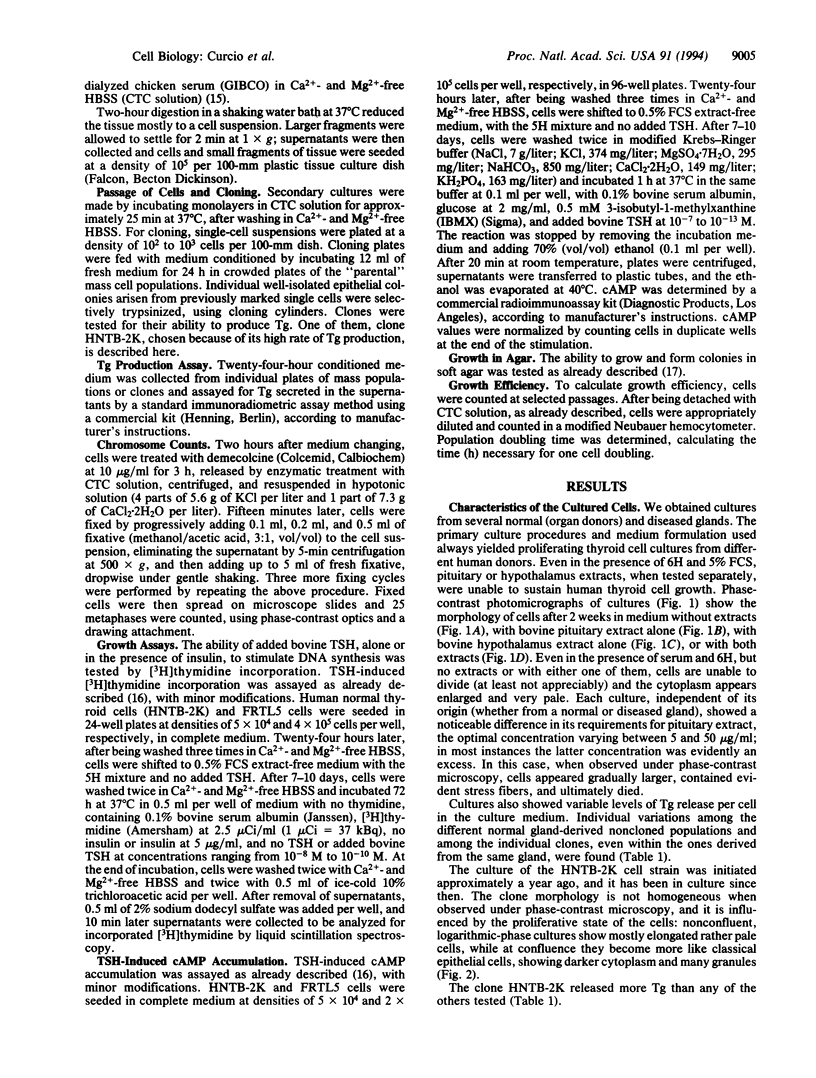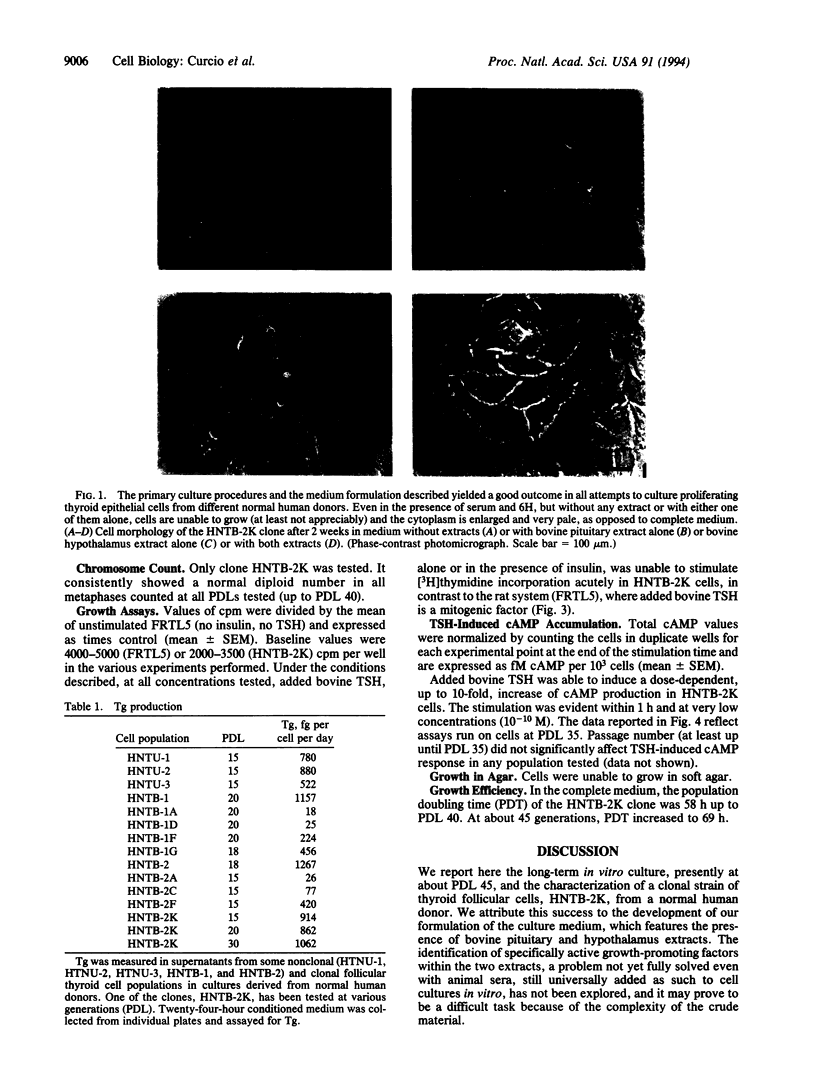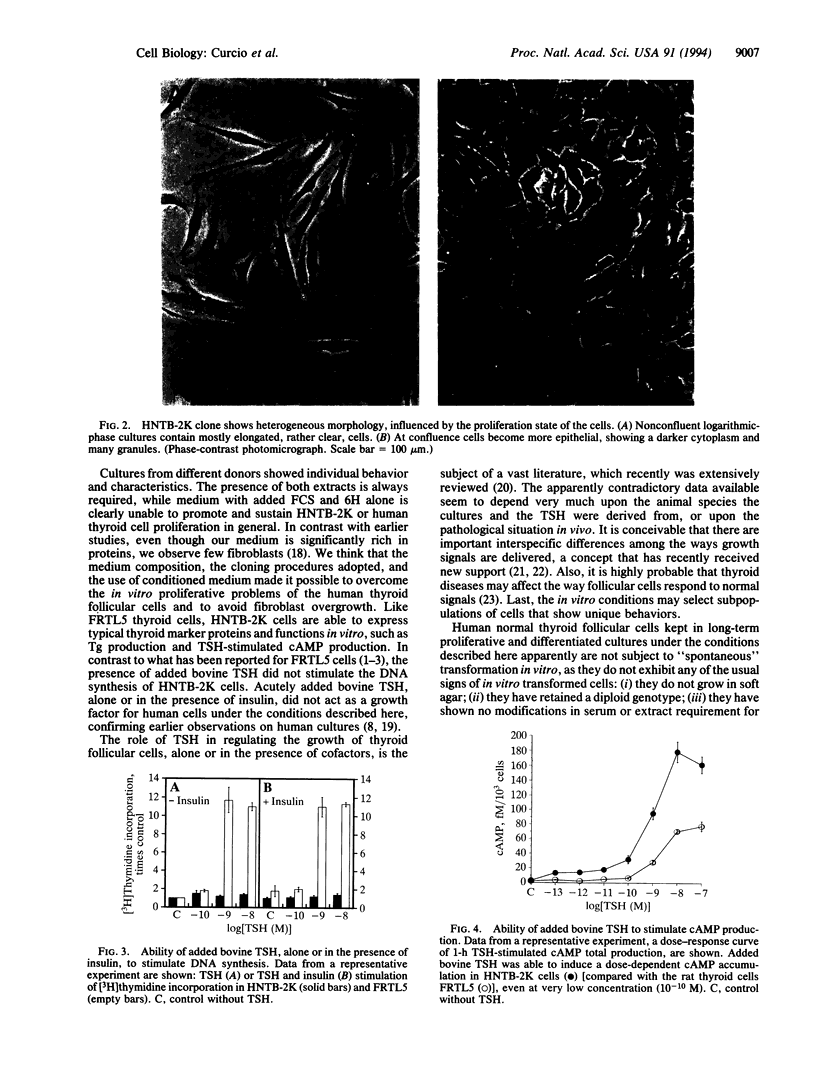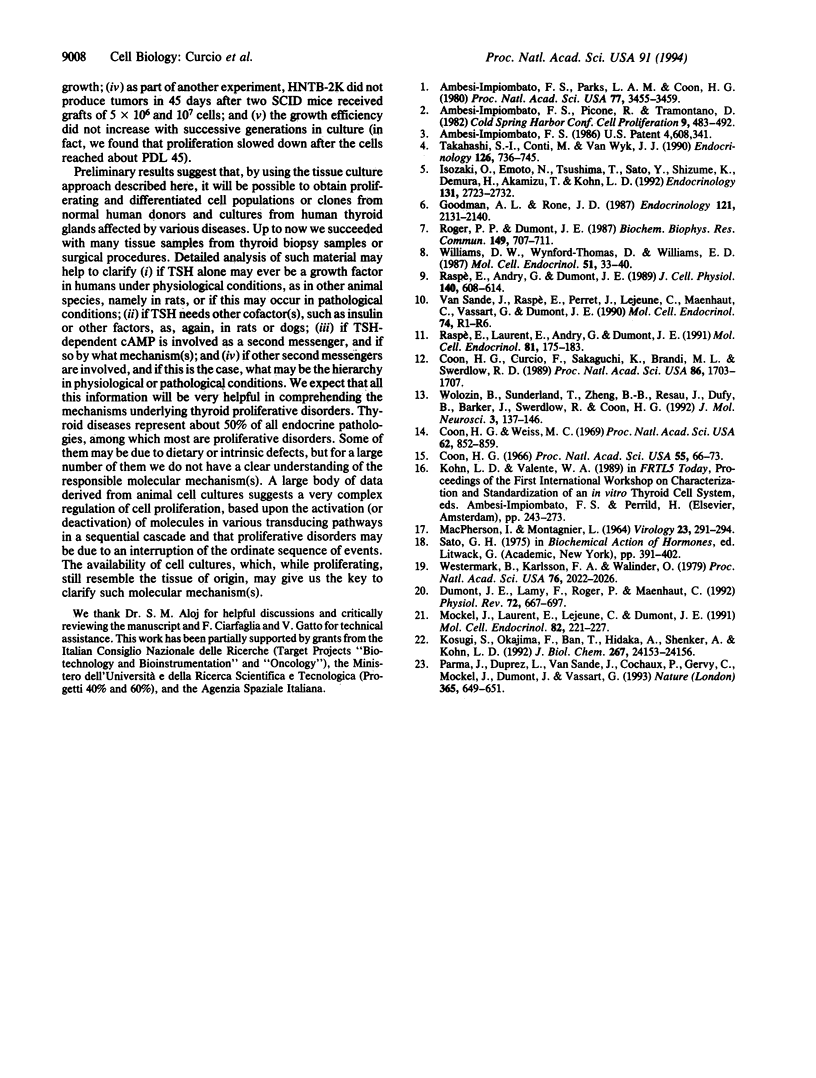Abstract
We have obtained long-term cultures of differentiated proliferating follicular cells from normal adult human thyroid glands. In vitro growth of such human cells has been sustained by a modified F-12 medium, supplemented with bovine hypothalamus and pituitary extracts and no added thyrotropin. Cultures have been expanded, cloned, frozen, successfully retrieved, and characterized. Functional characterization of these cells shows constitutive thyroglobulin production and release and thyrotropin-dependent adenosine 3',5'-cyclic monophosphate production, the latter apparently not associated with significant increases in DNA synthesis or cell proliferation. Genetic characterization of these cells by chromosome counting showed the normal diploid chromosome number. The ability to cultivate differentiated human thyroid follicular cells in long-term culture opens possibilities for investigating the transduction pathways of thyrotropin stimulation in normal and pathological human tissues, developing clinically relevant in vitro assays, and considering cellular and molecular therapies.
Full text
PDF




Images in this article
Selected References
These references are in PubMed. This may not be the complete list of references from this article.
- Ambesi-Impiombato F. S., Parks L. A., Coon H. G. Culture of hormone-dependent functional epithelial cells from rat thyroids. Proc Natl Acad Sci U S A. 1980 Jun;77(6):3455–3459. doi: 10.1073/pnas.77.6.3455. [DOI] [PMC free article] [PubMed] [Google Scholar]
- Coon H. G. Clonal stability and phenotypic expression of chick cartilage cells in vitro. Proc Natl Acad Sci U S A. 1966 Jan;55(1):66–73. doi: 10.1073/pnas.55.1.66. [DOI] [PMC free article] [PubMed] [Google Scholar]
- Coon H. G., Curcio F., Sakaguchi K., Brandi M. L., Swerdlow R. D. Cell cultures of neuroblasts from rat olfactory epithelium that show odorant responses. Proc Natl Acad Sci U S A. 1989 Mar;86(5):1703–1707. doi: 10.1073/pnas.86.5.1703. [DOI] [PMC free article] [PubMed] [Google Scholar]
- Coon H. G., Weiss M. C. A quantitative comparison of formation of spontaneous and virus-produced viable hybrids. Proc Natl Acad Sci U S A. 1969 Mar;62(3):852–859. doi: 10.1073/pnas.62.3.852. [DOI] [PMC free article] [PubMed] [Google Scholar]
- Dumont J. E., Lamy F., Roger P., Maenhaut C. Physiological and pathological regulation of thyroid cell proliferation and differentiation by thyrotropin and other factors. Physiol Rev. 1992 Jul;72(3):667–697. doi: 10.1152/physrev.1992.72.3.667. [DOI] [PubMed] [Google Scholar]
- Goodman A. L., Rone J. D. Thyroid angiogenesis: endotheliotropic chemoattractant activity from rat thyroid cells in culture. Endocrinology. 1987 Dec;121(6):2131–2140. doi: 10.1210/endo-121-6-2131. [DOI] [PubMed] [Google Scholar]
- Isozaki O., Emoto N., Tsushima T., Sato Y., Shizume K., Demura H., Akamizu T., Kohn L. D. Opposite regulation of deoxyribonucleic acid synthesis and iodide uptake in rat thyroid cells by basic fibroblast growth factor: correlation with opposite regulation of c-fos and thyrotropin receptor gene expression. Endocrinology. 1992 Dec;131(6):2723–2732. doi: 10.1210/endo.131.6.1332847. [DOI] [PubMed] [Google Scholar]
- Kosugi S., Okajima F., Ban T., Hidaka A., Shenker A., Kohn L. D. Mutation of alanine 623 in the third cytoplasmic loop of the rat thyrotropin (TSH) receptor results in a loss in the phosphoinositide but not cAMP signal induced by TSH and receptor autoantibodies. J Biol Chem. 1992 Dec 5;267(34):24153–24156. [PubMed] [Google Scholar]
- MACPHERSON I., MONTAGNIER L. AGAR SUSPENSION CULTURE FOR THE SELECTIVE ASSAY OF CELLS TRANSFORMED BY POLYOMA VIRUS. Virology. 1964 Jun;23:291–294. doi: 10.1016/0042-6822(64)90301-0. [DOI] [PubMed] [Google Scholar]
- Mockel J., Laurent E., Lejeune C., Dumont J. E. Thyrotropin does not activate the phosphatidylinositol bisphosphate hydrolyzing phospholipase C in the dog thyroid. Mol Cell Endocrinol. 1991 Dec;82(2-3):221–227. doi: 10.1016/0303-7207(91)90035-q. [DOI] [PubMed] [Google Scholar]
- Parma J., Duprez L., Van Sande J., Cochaux P., Gervy C., Mockel J., Dumont J., Vassart G. Somatic mutations in the thyrotropin receptor gene cause hyperfunctioning thyroid adenomas. Nature. 1993 Oct 14;365(6447):649–651. doi: 10.1038/365649a0. [DOI] [PubMed] [Google Scholar]
- Raspé E., Andry G., Dumont J. E. Adenosine triphosphate, bradykinin, and thyrotropin-releasing hormone regulate the intracellular Ca2+ concentration and the 45Ca2+ efflux of human thyrocytes in primary culture. J Cell Physiol. 1989 Sep;140(3):608–614. doi: 10.1002/jcp.1041400328. [DOI] [PubMed] [Google Scholar]
- Raspé E., Laurent E., Andry G., Dumont J. E. ATP, bradykinin, TRH and TSH activate the Ca(2+)-phosphatidylinositol cascade of human thyrocytes in primary culture. Mol Cell Endocrinol. 1991 Oct;81(1-3):175–183. doi: 10.1016/0303-7207(91)90216-f. [DOI] [PubMed] [Google Scholar]
- Roger P. P., Dumont J. E. Thyrotropin is a potent growth factor for normal human thyroid cells in primary culture. Biochem Biophys Res Commun. 1987 Dec 16;149(2):707–711. doi: 10.1016/0006-291x(87)90425-6. [DOI] [PubMed] [Google Scholar]
- Takahashi S., Conti M., Van Wyk J. J. Thyrotropin potentiation of insulin-like growth factor-I dependent deoxribonucleic acid synthesis in FRTL-5 cells: mediation by an autocrine amplification factor(s). Endocrinology. 1990 Feb;126(2):736–745. doi: 10.1210/endo-126-2-736. [DOI] [PubMed] [Google Scholar]
- Westermark B., Karlsson F. A., Wålinder O. Thyrotropin is not a growth factor for human thyroid cells in culture. Proc Natl Acad Sci U S A. 1979 Apr;76(4):2022–2026. doi: 10.1073/pnas.76.4.2022. [DOI] [PMC free article] [PubMed] [Google Scholar]
- Williams D. W., Wynford-Thomas D., Williams E. D. Control of human thyroid follicular cell proliferation in suspension and monolayer culture. Mol Cell Endocrinol. 1987 May;51(1-2):33–40. doi: 10.1016/0303-7207(87)90116-x. [DOI] [PubMed] [Google Scholar]
- Wolozin B., Sunderland T., Zheng B. B., Resau J., Dufy B., Barker J., Swerdlow R., Coon H. Continuous culture of neuronal cells from adult human olfactory epithelium. J Mol Neurosci. 1992;3(3):137–146. doi: 10.1007/BF02919405. [DOI] [PubMed] [Google Scholar]




